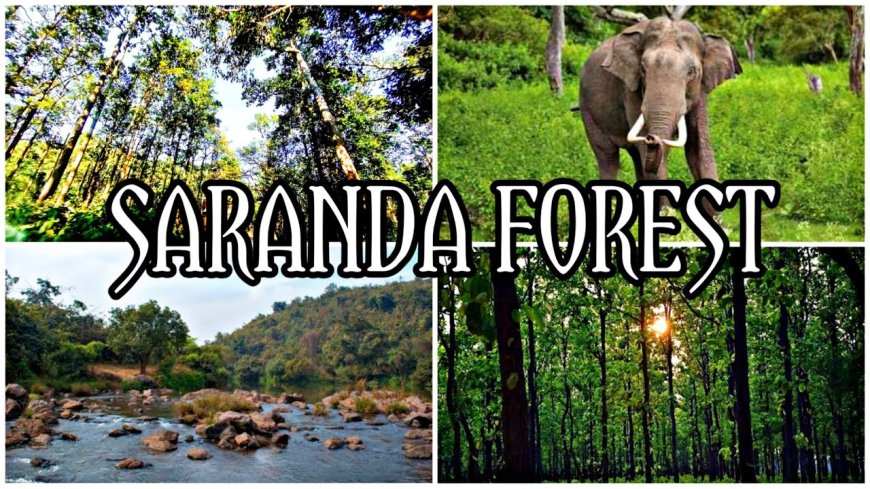Saranda Forest Jharkhand- The Land of Seven Hundreds Hills

Saranda Forest Jharkhand
Saranda Forest, also known as Saranda Jungle or Saranda Sal Forest, is a dense forest located in the Indian state of Jharkhand. It is one of the largest and oldest Sal forests in Asia, covering an area of approximately 820 square kilometers. It is also called the land of 700 hills. The forest is named after the nearby town of Saranda, which is known for its natural beauty and rich biodiversity.
Saranda Forest is home to a diverse range of flora and fauna, including several endangered and rare species. The dominant tree species in the forest is Sal (Shorea robusta), which is highly valued for its timber and is commercially exploited in some areas. Other tree species found in the forest include Mahua, Bamboo, Piasal, Simarouba, and many more.
The forest provides a vital habitat for various wildlife species, including elephants, tigers, leopards, deer, sloth bears, reptiles, and a wide variety of bird species. Saranda Forest is considered an important wildlife corridor connecting the neighboring forests of Jharkhand and Odisha, allowing for the movement of wildlife across different regions.
In recent years, there have been efforts to conserve and protect Saranda Forest due to increasing deforestation and illegal mining activities. Various initiatives have been undertaken by the government and non-governmental organizations to promote sustainable practices, create awareness about the importance of forest conservation, and safeguard the rich biodiversity of the region.
Tourism in Saranda Forest is also gaining popularity, attracting nature enthusiasts, birdwatchers, and adventure seekers. Visitors can explore the forest through guided nature walks, wildlife safaris, and trekking trails, allowing them to experience the beauty and tranquility of this pristine natural landscape.
The forest is of great ecological significance and plays a crucial role in maintaining the local climate, water resources, and soil fertility. It also supports the livelihoods of indigenous communities residing in and around the forest, who rely on forest resources for their sustenance and cultural practices.
Value of Saranda Forest
The value of Saranda Forest is multi-faceted, encompassing ecological, economic, cultural, and recreational aspects. Here are some key aspects of its value:
-
Ecological Value: Saranda Forest is a crucial ecosystem that supports a diverse range of flora and fauna. The forest acts as a habitat for numerous plant and animal species, including several endangered and rare ones. It plays a significant role in maintaining local climate patterns, water resources, and soil fertility. The forest also acts as a wildlife corridor, facilitating the movement of animals between different forested areas.
-
Economic Value: Saranda Forest holds economic value through various means. The forest is a source of timber, with Sal wood being highly valued in the market. Local communities depend on the forest for non-timber forest products like Mahua flowers, leaves, and seeds, which are used for food, medicine, and livelihood purposes. The forest also has the potential for sustainable eco-tourism, attracting visitors and generating income for local communities.
- Biodiversity Value: Saranda Forest's rich biodiversity contributes to its value. The forest harbors a variety of plant species, including valuable timber species like Sal, along with medicinal plants and other important flora. The diverse wildlife found in the forest, including elephants, tigers, and numerous bird species, adds to its ecological significance and attractiveness.
-
Cultural Value: Saranda Forest holds cultural significance for indigenous communities living in and around the forest. These communities have a deep connection with the forest, relying on it for their traditional practices, rituals, and livelihoods. The forest is intertwined with their cultural heritage, serving as a source of inspiration and spiritual connection.
-
Recreational Value: Saranda Forest offers recreational opportunities for nature enthusiasts, adventure seekers, and tourists. Its serene and natural beauty attracts visitors who enjoy activities such as wildlife safaris, trekking, birdwatching, and nature walks. The forest provides an escape from urban life and offers a chance to connect with nature and appreciate its wonders.
Forest Type
The forest type of Saranda Forest is classified as a tropical deciduous forest. It is predominantly composed of Sal (Shorea robusta) trees, which are characteristic of this forest type. Tropical deciduous forests are found in regions with distinct wet and dry seasons, and the trees in these forests shed their leaves during the dry season to conserve water.
In addition to Sal trees, Saranda Forest may also have other tree species such as Mahua (Madhuca longifolia), Bamboo (Bambusoideae), Piasal (Pterocarpus marsupium), Simarouba (Simarouba glauca), and various other associated species. These forests have a diverse understory vegetation and support a wide range of wildlife species, including mammals, birds, reptiles, and insects.
Why is Saranda forest fomous for :
Saranda Forest is famous for several reasons:
-
Biodiversity: Saranda Forest is renowned for its rich biodiversity. It is home to a wide variety of plant and animal species, including several endangered and rare species. The forest's diverse ecosystem attracts nature enthusiasts, researchers, and wildlife lovers who appreciate the unique flora and fauna found in the area.
-
Sal Forest: Saranda Forest is one of the largest and oldest Sal forests in Asia. Sal (Shorea robusta) is a valuable timber species, and the forest's abundance of Sal trees contributes to its fame. Sal wood is highly valued in the market for its durability and strength, making it a significant economic resource.
-
Wildlife: The forest provides habitat to numerous wildlife species, including elephants, tigers, leopards, sloth bears, deer, reptiles, and a variety of bird species. The presence of these charismatic and diverse wildlife populations adds to the fame and appeal of Saranda Forest, attracting wildlife enthusiasts and photographers.
-
Cultural Significance: Saranda Forest holds cultural significance for the indigenous communities living in the region. These communities have a deep connection with the forest and rely on it for their livelihoods and traditional practices. The forest is associated with their cultural heritage, rituals, and spiritual beliefs, making it a place of cultural importance.
- Conservation Efforts: Saranda Forest has gained recognition for conservation efforts undertaken to protect its biodiversity and combat threats such as deforestation and illegal mining. These conservation initiatives have drawn attention to the forest's ecological significance and have helped raise awareness about the importance of preserving such natural habitats.
What's Your Reaction?




















































